Best Managed Switch For Home (2024 Update)
Looking to upgrade your home network with a new managed switch? With so many options on the market, it can be overwhelming to choose the right one. This introductory guide will walk you through the key factors to consider before investing in a managed switch for your home.
First, think about your current and future connectivity needs. How many wired devices do you have now and plan to add in the coming years? The number of ports you require is a primary consideration. Also, what speeds do you need – 10Gb, 5Gb, 2.5Gb, 1Gb? Higher speeds allow for faster file transfers and multiple high-bandwidth applications running simultaneously.
Next, consider the physical environment and size limitations. Is the switch going in a closet, basement, or living area? What dimensions can it fit within? Managed switches come in a wide variety of form factors, from small desktop units to full-sized rackmountable ones. Ensure you choose a form factor suitable for the intended installation space.
You’ll also want to weigh management capabilities and ease of use. Many managed switches have web UIs, while some are accessible only via a command line. If you’re less experienced with network administration, prioritize models with intuitive browser-based controls for port monitoring, VLANs, link aggregation, and more.
Lastly, don’t forget about budget. Managed switches span a wide gamut of price points. Set realistic expectations based on the features you require and how much you’re willing to spend. With the right considerations in mind, you’re sure to find the ideal managed switch to upgrade your home network.
Ready to start shopping? What factors are most important for your situation? How many devices will you need to connect? What about remote management capabilities? Keep reading for detailed reviews and recommendations of the top managed switches for home networks.
10 Best Managed Switch For Home
| # | Product Image | Product Name | Product Notes | Check Price |
|---|---|---|---|---|
|
1
|
The product is ideal for small to medium-sized businesses requiring a reliable and high-performing network switch with PoE capabilities.
|
|
||
|
2
|
The product is ideal for managing and powering multiple compatible devices using a smart, efficient system through gigabit connections.
|
|
||
|
3
|
Ideal for businesses that require a smart managed PoE switch with 8 PoE+ ports, SFP slots, IPv6, and static routing.
|
|
||
|
4
|
The product is ideal for managing and connecting multiple devices in a network, providing fast data transfer rates and security features.
|
|
||
|
5
|
Ideal for managing multiple network connections and ensuring efficient data transfer with features such as QoS, VLAN, IGMP, and Link Aggregation.
|
|
||
|
6
|
Ideal for businesses that require high-speed data transfer and connectivity, with advanced security features and reliable performance.
|
|
||
|
7
|
Ideal for businesses needing a high-performance switch with advanced management features, PoE support, and reliable connectivity.
|
|
||
|
8
|
Ideal for managing high-speed network traffic and providing connectivity in backbone networks for businesses and organizations.
|
|
||
|
9
|
Ideal for providing power and connectivity to multiple devices in an office or business with high-speed Ethernet capability.
|
|
||
|
10
|
This product is ideal for managing multiple high-speed Ethernet connections and provides easy plug and play setup.
|
|
1. Instant On 24-Port Ethernet Smart Switch

The Aruba Instant On 1930 24G Class 4 PoE 4SFP/SFP+ 370W Switch is a highly effective and smartly managed switch, specially designed for small and medium sized businesses. This switch is incredibly easy to set up and manage, and provides a level of security that you can trust.
One of the standout features of this switch is its Two-Factor Authentication, which provides an added layer of security to your network. The switch also boasts a rack-width design with rack mounting ears, though it can also be placed on a desktop or flat surface. All ports and LEDs are conveniently located on the front, and the device is equipped with an internal power supply and US-style plug.
Management of the Aruba Instant On 1930 24G switch is made easier with simplified cloud management available through the Aruba Instant On mobile app or web browser. There are no recurring costs associated with this management system, which allows you to set up, manage, and monitor your network from anywhere using your phone. Guided step-by-step instructions make it easy to install devices and get your network up and running quickly, without requiring any technical expertise. For advanced configuration, the switch also offers an alternative integrated traditional full local web interface with static routing, ACLs, and SNMP.
In terms of ports, the Aruba Instant On 1930 24G switch offers a total of 28 active ports, including 24x Gigabit 10/100/1000 ports and 4x Gigabit/10G SFP+ slots. The switch also supports PoE/PoE+ (Class 4) on all 24 ports, with a total PoE power budget of 370 Watts. This switch is future-proof, ensuring high performance for years to come.
2. Tp-Link Tl-Sg2428p | Jetstream 24 Port Gigabit Smart Managed Poe
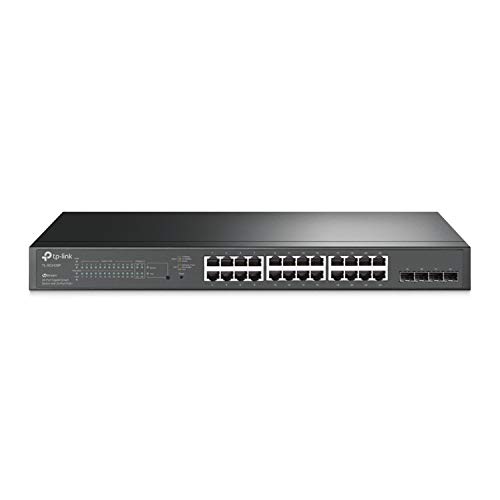
The Flexible Full Gigabit 28-Port PoE Configuration is a high-performance switch that offers a variety of features designed to enhance network security, management, and performance. With 24 PoE+ (802.3at/af) 10/100/1000 Mbps RJ45 ports that provide up to 30W per port, and a total PoE power budget of 250W, it has the power to meet the needs of even the most demanding network environments. Additionally, it features 4 Gigabit SFP slots for high-speed connections.
The switch is integrated into the Omada SDN platform, which allows for easy management and control of network devices, including switches, access points, and gateways. Users have multiple control options available, including the Omada Hardware controller and the Omada Software Controller. It can also be used in Standalone Mode.
One of the standout features of this switch is its cloud access capability. With remote cloud access and the Omada app, users can enjoy centralized cloud management of the entire network from different sites, all controlled from a single interface, anywhere and anytime.
To ensure SDN compatibility, users must ensure that their devices/controllers are either equipped with or can be upgraded to the SDN version. It's important to note that SDN controllers only work with SDN switches, access points, and gateways, while non-SDN controllers work only with non-SDN access points. To find devices that are compatible with SDN firmware, users can visit the TP-Link website.
The switch is also equipped with advanced security features, including 802.1Q VLAN, IP-MAC-Port binding, ACL, Port Security, DoS defend, Storm control, DHCP Snooping, 802.1X radius authentication, and more. These features help to enhance network security and prevent unauthorized access.
In addition to its advanced security features, the switch also boasts advanced software features that prioritize traffic and guarantee high quality of video or voice data transmission. These features include L2/L3/L4 QoS, IGMP Snooping, Link Aggregation, and Flow Control.
Finally, the switch is backed by TP-Link's industry-leading limited lifetime warranty and free 24/7 technical support, providing users with the peace of mind they need to work with confidence.
3. Jetstream Poe+ Gigabit Switch With Omada Sdn
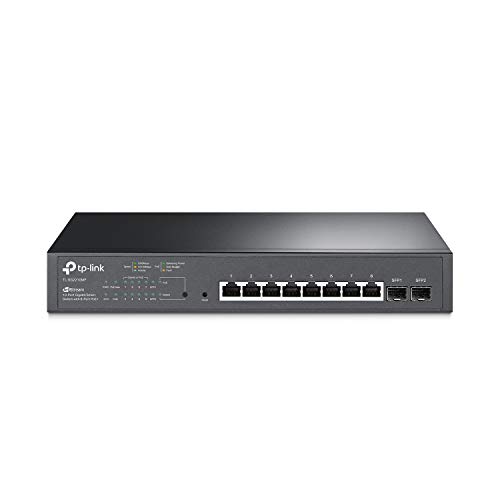
The Flexible Full Gigabit 10-Port PoE Configuration is a reliable network switch that offers multiple features to enhance network connectivity and management. With 8x PoE+ (802.3at/af) 10/100/1000 Mbps RJ45 ports, the switch delivers up to 30W per port and a total PoE power budget of 150W. The switch also comes with 2x Gigabit SFP Slots, which ensure high-speed connections.
The switch is integrated into Omada's Software Defined Networking (SDN) platform, which allows for the integration of network devices such as switches, access points, and gateways. The platform offers multiple control options, including the Omada Hardware controller, Omada Software Controller, or Omada Cloud-based controller*(Contact TP-Link for Cloud-based controller plan details). The switch can also operate in standalone mode.
The switch is cloud-accessible, allowing for remote cloud access and centralized cloud management of the entire network from different sites, all controlled from a single interface. The Omada app makes management easy, no matter where you are.
To ensure SDN compatibility, users should ensure their devices/controllers are equipped with or can be upgraded to the SDN version. SDN controllers only work with SDN switches, access points, and gateways, while non-SDN controllers only work with non-SDN access points. Compatible devices with SDN firmware can be found on the TP-Link website.
The switch offers advanced security features, including 802.1Q VLAN, IP-MAC-Port binding, ACL, Port Security, DoS defend, Storm control, DHCP Snooping, 802.1X radius authentication, and more. Network security is enhanced, ensuring that only authorized devices get access to the network.
The switch also offers advanced software features, such as prioritizing traffic to guarantee high-quality video or voice data transmission. L2/L3/L4 QoS, IGMP Snooping, Link Aggregation, and Flow Control are also included.
4. Cisco 24-Port Business Managed Switch With Lifetime Protection
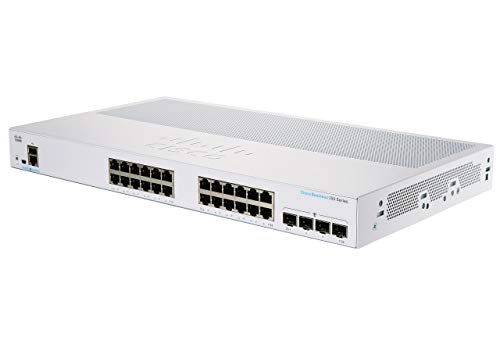
This switch is a top-of-the-line networking solution that boasts impressive features and capabilities. With 24 ports that support 10/100/1000 speeds and 4 x 10GE SFP+ ports, this switch is versatile and can handle a variety of network demands. Its intuitive Cisco Business Dashboard and on-box U/I make it easy to operate and automate lifecycle management, streamlining network operations.
The switch's extensive portfolio provides ultimate flexibility, offering models with 8 to 48 ports and PoE+ combinations. This allows for customization to meet specific business needs.
In terms of security, the switch features IP-MAC port binding, which detects and blocks deliberate network attacks. IPv6 First Hop Security adds an extra layer of protection against a vast range of address spoofing and man-in-the-middle attacks on IPv6 networks.
The switch's innovative design is elegant and compact, making it ideal for installation outside of a wiring closet, such as in retail stores, open plan offices, and classrooms.
Energy efficiency is also a priority with this switch, as it optimizes power usage to lower operational costs. It is compliant with IEEE802.3az Energy Efficient Ethernet and is fanless in most models.
To give users peace of mind, this switch comes with a limited-lifetime warranty with Next-Business-Day advance replacement (where available) and one-year technical support. Overall, this switch is an excellent choice for businesses that need a flexible, secure, energy-efficient, and easy-to-use networking solution.
5. Smartplug Gigabit Switch With Lifetime Protection
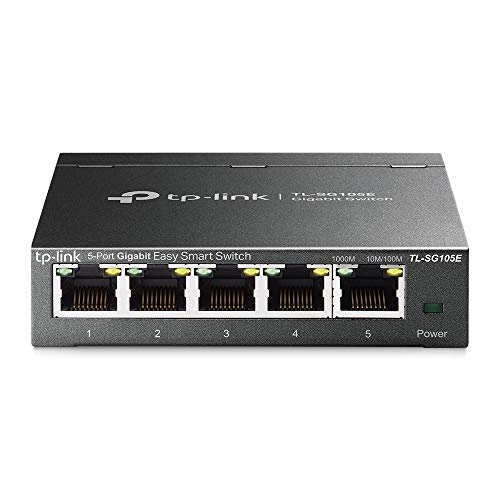
The 5-Gigabit ports of this product allow for instant and seamless large file transfers, making it an ideal choice for those who require speedy data transfer capabilities. Additionally, the product's 15K jumbo frame feature enhances the performance of large data transfers, making it even more efficient.
The network monitoring capabilities of this product are also impressive, thanks to its port mirroring, loop prevention, and cable diagnostics features. These tools allow for effective network monitoring and troubleshooting, ensuring that any issues are resolved quickly and efficiently.
For those concerned about network security, this product offers a range of VLAN features that improve security by segmenting traffic. The Igmp snooping feature also optimizes multicast applications, improving network efficiency and reducing potential errors.
Latency-sensitive traffic is also well-managed with this product's port and tag-based QoS, enabling smooth data transfer and minimizing the risk of data loss or corruption.
Customers can rest assured knowing that this product comes with a limited lifetime warranty and 24/7 tech support, providing added peace of mind and support. Its system RAM type is DDR3 SDRAM, ensuring reliable and efficient performance.
6. Cisco Cbs350-12xs: Power Your Network!
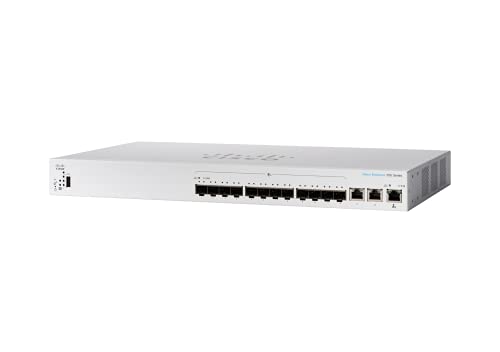
The 12-Port 10G SFP+ switch with 2 x 10GE ports is a versatile and flexible networking solution, perfect for various business settings. The device has an extensive portfolio that provides flexibility from 8 to 48 10G copper or SFP+ ports, allowing for easy customization.
The switch features an intuitive on-box UI, mobile app, and Cisco Business Dashboard, which simplifies network operations and automates lifecycle management. This makes it easy to manage and monitor your network, even if you're not a networking expert.
For added security, the switch has IP-MAC port binding that detects and blocks deliberate network attacks. IPv6 First Hop Security provides protection on IPv6 networks, while RIP dynamic routing simplifies routing configurations in a complex network. These features make the switch a reliable and secure networking solution.
The switch has an elegant and compact design, making it ideal for installation outside of the wiring closet. It can be used in retail stores, open-plan offices, and classrooms, making it a perfect solution for various settings.
The device is energy-efficient and optimizes power usage to lower operational costs. It is compliant with IEEE802.3az Energy Efficient Ethernet and is fanless in most models, making it a quiet and energy-efficient solution.
The switch comes with a limited lifetime hardware warranty with Next-Business-Day advance replacement (where available) and one-year technical support, giving you peace of mind. Overall, the 12-Port 10G SFP+ switch with 2 x 10GE ports is an excellent choice for businesses looking for a flexible, reliable, and secure networking solution.
7. Cloud-Managed 24-Port Gigabit Switch With Poe.
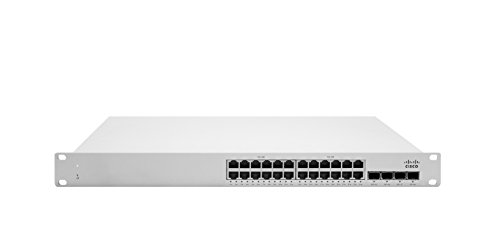
The 24 Port Gigabit Ethernet switch is a top-of-the-line networking solution for businesses of any size. With 4x SFP uplinks and Layer 3 capabilities, this switch offers high-speed connectivity and advanced network functionality.
One of the standout features of this switch is its 80G physical stacking, which allows for seamless expansion and scalability of your network. Additionally, the non-blocking switch fabric ensures optimal performance even during periods of heavy network traffic.
The switch also offers Voice and Video Quality of Service (QoS), which prioritizes these types of traffic to ensure clear and uninterrupted communication. Additionally, it supports Cisco Redundant Power System, providing added protection against power outages.
This switch also features cloud management, monitoring, and diagnostics capabilities, allowing for easy remote management and troubleshooting. Email and text message alerts can be set up to notify administrators of any issues that may arise.
With 370W Power Over Ethernet (PoE), this switch can power a variety of devices, including access points, cameras, and phones. It should be noted that cloud licensing is required for PoE, and must be purchased separately.
8. Qsw-M5216: High-Speed Managed Network Switch.
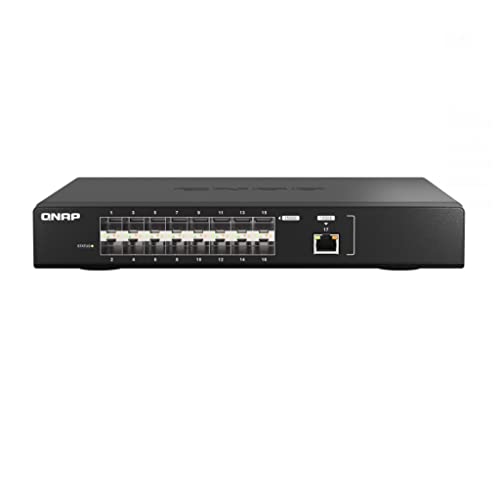
The QSW-M5216-1T-US is a high-performance network switch designed for modern server rooms. With 16-port 25GbE SFP28 fiber ports and a backbone switching capacity of 820Gbps, this switch offers unparalleled uplinking capabilities.
Additionally, the QSW-M5216-1T-US features a 10GBASE-T port that supports five speeds (10G / 5G / 2.5G / 1G / 100M), making it ideal for hybrid high-speed network deployments.
Powered by QNAP's QSS (QNAP Switch System) switch OS, the QSW-M5216-1T-US comes with an easy-to-use Web GUI and value-added functions that simplify network set up and management. This allows users to streamline their network and focus on more important tasks.
The QSW-M5216-1T-US also supports Layer 2 management features, such as LACP, VLAN, ACL, and LLDP, for network bandwidth management and security. These features provide users with greater control over their network and ensure that their data is secure.
Compliant with IEEE 802.3az Energy Efficient Ethernet and IEEE802.3x Flow Control in full-duplex mode, the QSW-M5216-1T-US is an energy-efficient option that reduces power consumption for low-speed and inactive connections. This makes it an ideal choice for those looking to reduce their power usage and save on energy costs.
9. Pro Poe Gigabit 24-Port Switch
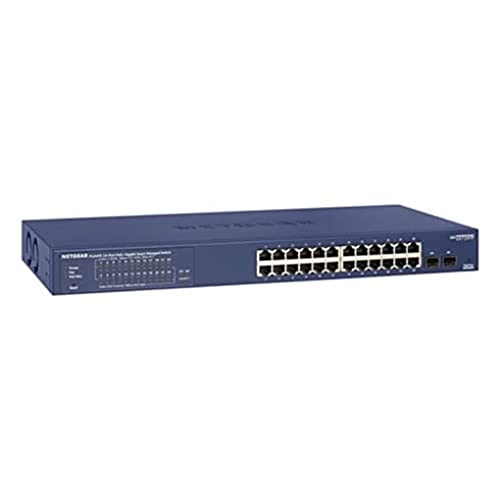
The NETGEAR Ethernet Switch is a reliable and powerful solution for businesses and home offices in need of advanced network control. With 24 Gigabit ports, the switch offers high-speed connectivity for a variety of devices. Additionally, the 24 PoE+ ports come with a total power budget of 190W, making it easy to power compatible devices without the need for additional power sources.
For added flexibility, the switch comes equipped with 2 x 1G SFP ports, allowing for easy uplink to other devices. The advanced configuration and control software is easy to use with a GUI interface, giving users refined control over secure setup, access, and SNMP management.
The NETGEAR Ethernet Switch offers versatile mounting options, including desktop or rackmount placement, and includes all the necessary mounting hardware in the box. The whisper-quiet design reduces fan noise, making it a great option for home offices or other environments where noise is a concern.
The switch is energy efficient, designed to optimize power usage and lower operating costs. Most models are compliant with IEEE802.3az Energy Efficient Ethernet mode, making it an eco-friendly choice for businesses and individuals looking to reduce their carbon footprint.
NETGEAR is committed to quality, which is why every network switch is rigorously tested for reliability, quality, and performance. The switch is also covered by an industry-best Lifetime Limited Hardware Warranty, Next Business Day Replacement, and 24/7 chat with a NETGEAR expert, ensuring that customers will be well taken care of if any issues arise.
10. Zyxel Multi-Gig Ethernet Switch: Fast And Versatile.
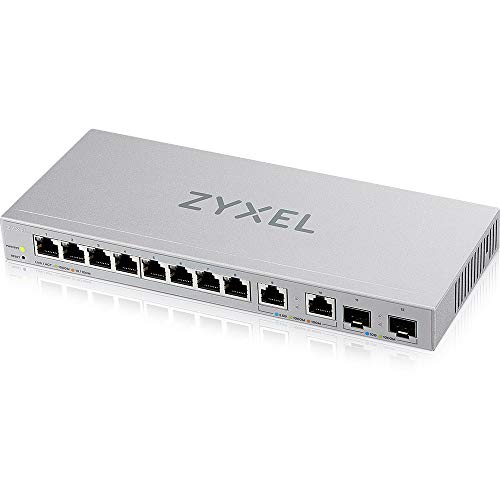
The Zyxel XGS1210-12 is a high-performance Multi-Gigabit Ethernet switch that offers lightning-fast connectivity for bandwidth-intensive applications. With 2 x 2.5Gbps ports, 2 x 10G SFP+ ports, and 8 Gigabit Ethernet ports, this switch provides robust connectivity options that meet the demands of today's modern networks.
The XGS1210-12 is equipped with advanced smart managed features, including VLAN, QoS, and Link Aggregation, which allow you to optimize your network for performance and reliability. This makes it an ideal choice for businesses and IT professionals who need a switch that can handle the demands of complex networks.
Despite its powerful capabilities, the XGS1210-12 is designed with a compact form factor and operates quietly, making it an excellent option for small offices and home use. Its intuitive web-based GUI provides a user-friendly interface for network management, allowing you to easily monitor and configure your network settings.
Zyxel stands behind the quality of the XGS1210-12 with a limited lifetime warranty and a US-based support team, giving you peace of mind that your investment is protected. Whether you're looking to upgrade your network or build a new one from scratch, the Zyxel XGS1210-12 is an excellent choice that delivers exceptional performance and reliability.
Best Managed Switch For Home FAQs
Can a managed switch improve the performance of my home network?
Yes, a managed switch can improve the performance of your home network. A managed switch offers more control and flexibility over your network compared to an unmanaged switch. With a managed switch, you can prioritize network traffic, set up VLANs, and monitor network performance. Prioritizing network traffic allows you to give more bandwidth to certain devices or applications that require it, such as gaming or streaming services. VLANs can be used to separate and secure different devices or parts of your network, such as separating your home office network from your entertainment network. Monitoring network performance can help you identify any issues or bottlenecks in your network and optimize it for better performance. Overall, a managed switch can provide greater control and customization options for your home network, leading to improved performance and better user experience.
Can I configure a managed switch for my home network without any technical expertise?
Configuring a managed switch for your home network can seem like a daunting task, especially if you have no technical expertise. However, with the right resources and some basic knowledge, it is definitely possible to configure a managed switch on your own.
First, it is important to read the manual or user guide that comes with your managed switch. This will give you an overview of the features and functions of the switch and guide you through the setup process.
Next, you will need to access the switch's configuration interface, typically through a web browser. Once you are logged in, you can configure settings such as VLANs, port forwarding, and QoS.
If you are unsure about any of the settings or terminology, there are plenty of online resources and forums that can help you troubleshoot and find answers to your questions. It may also be helpful to reach out to the manufacturer or a tech support service for further assistance.
Overall, while configuring a managed switch may require some technical knowledge, it is definitely possible to do so with the right resources and a bit of patience.
Do I need a managed switch if I only have a few devices on my home network?
A managed switch is a networking device that allows you to configure and monitor your network. It provides more control and flexibility over your network compared to an unmanaged switch. However, if you only have a few devices on your home network, you may not necessarily need a managed switch.
An unmanaged switch can handle the traffic of a small home network. It is a plug-and-play device that requires no configuration, making it a more cost-effective option for a home network with a few devices. On the other hand, if you have more advanced requirements for your home network such as VLANs, Quality of Service (QoS), or link aggregation, a managed switch may be beneficial.
In summary, if you only have a few devices on your home network and do not require advanced network configurations, an unmanaged switch may be sufficient. However, if you have more advanced networking needs, a managed switch may provide more control and flexibility to manage your network.
How many ports do I need on a managed switch for my home network?
The number of ports required on a managed switch for a home network depends on the number of devices that you want to connect to your network. Managed switches come in different port configurations ranging from 5 to 48 ports. If you have a small home network with just a few devices to connect, a managed switch with 5-8 ports would suffice. However, if you have a larger network with multiple devices such as computers, printers, gaming consoles, and smart home devices, you may need a switch with more ports.
It's always a good practice to plan for future expansion of your network when choosing a managed switch. You may want to consider a switch with more ports than you currently need, so you don't have to upgrade in the future when you add more devices to your network. Additionally, it's essential to ensure that the switch you choose supports the latest technology and has the features you need for your home network. Overall, the number of ports you need on a managed switch for your home network depends on your current and future network requirements.
How much should I expect to spend on a good quality managed switch for my home network?
The cost of a good quality managed switch for your home network can vary depending on your specific needs and the features you require. However, on average, you can expect to spend anywhere from $50 to $500 for a reliable and high-quality managed switch.
Basic managed switches with fewer ports and limited features can be found in the lower price range, while more advanced switches with more ports, advanced security features and greater bandwidth capabilities will cost more.
It's important to consider the size of your network, the number of devices you need to connect, and the level of control and management you require before making a purchase.
Additionally, it's worth investing in a reputable brand that offers a good warranty and customer support. It may be tempting to go for a cheaper option, but investing in a high-quality managed switch will save you money and frustration in the long run.
Is it worth investing in a high-end managed switch for my home network?
Investing in a high-end managed switch for your home network can be a good decision, but it ultimately depends on your specific needs and budget. Managed switches offer more advanced features and customization options than unmanaged switches, such as VLANs, QoS, and link aggregation. These features can be beneficial for larger homes or for users who require more network control and optimization.
However, if your home network is relatively small and you only need basic connectivity, an unmanaged switch may suffice. Additionally, high-end managed switches can be quite expensive, so it's important to consider if the added features are worth the cost.
Overall, if you have a larger home network with multiple devices and users, and require more advanced network management and optimization, investing in a high-end managed switch may be worth it. But if you have a smaller network and don't need advanced features, an unmanaged switch may be a more cost-effective solution.
What are the benefits of using a managed switch for home networking?
Using a managed switch for home networking provides several benefits. Firstly, it offers greater control over the network. This means you can prioritize traffic, monitor usage and configure the switch to suit your needs. Additionally, managed switches often have more advanced security features such as VLANs, which can help protect your home network from cyber threats.
Secondly, a managed switch offers better performance. With a managed switch, you can configure the switch to support specific applications, ensuring that they receive the necessary bandwidth and reducing network congestion. This can result in faster download and upload speeds, and a smoother overall network experience.
Thirdly, a managed switch is more scalable. As your network grows, a managed switch can be easily expanded with additional ports, without the need for additional hardware.
Overall, while a managed switch may be more expensive than an unmanaged switch, it provides greater control, improved performance, and better scalability, making it a worthwhile investment for those looking to optimize their home network.
What features should I look for in a managed switch for my home network?
When choosing a managed switch for your home network, there are several features you should look for to ensure that it meets your needs. The first thing to consider is the number of ports that the switch has, as this will determine how many devices you can connect to the network. You should also look for a switch that supports VLANs, which allow you to segment your network for added security and better organization.
Another important feature to consider is Quality of Service (QoS) support, which prioritizes certain types of traffic over others to ensure that your network runs smoothly. Additionally, you should look for a switch that supports Link Aggregation Control Protocol (LACP), which allows you to combine multiple physical connections into a single logical connection for improved performance and redundancy.
Lastly, make sure that the switch has a user-friendly interface that allows you to easily configure and manage your network. Advanced features like SNMP support and port mirroring may also be useful depending on your specific needs. Overall, a well-equipped managed switch will provide you with greater control and flexibility over your home network, allowing you to customize it to your specific requirements.
What is the best brand of managed switch for home networking?
When it comes to managed switches for home networking, there are several options available in the market. However, the best brand of managed switch for home networking would depend on your specific needs and requirements.
Some popular brands that offer quality managed switches suitable for home networking include Netgear, TP-Link, Cisco, and D-Link. Netgear is known for its user-friendly interface and easy setup process. TP-Link offers affordable solutions with reliable performance. Cisco is recognized for its advanced features and superior performance, but it may come with a higher price tag. D-Link is known for its durable switches that can handle heavy usage and can be customized according to your needs.
Before selecting a managed switch, consider the number of devices you have, the required bandwidth, and any specific features you may need. It is always recommended to do some research and read reviews to determine which brand and model would be the best fit for your home networking needs.
What is the difference between a managed switch and an unmanaged switch for home networking?
Managed and unmanaged switches are two types of network switches that can be used to connect multiple devices in a home network. The key difference between the two is that a managed switch provides more control and advanced features, while an unmanaged switch is simpler and easier to use.
An unmanaged switch is a plug-and-play device that requires no configuration. It is designed to automatically detect and connect devices in a network. Unmanaged switches are typically used in small home networks where there is no need for advanced management features such as VLANs or Quality of Service (QoS).
On the other hand, a managed switch is a more sophisticated device that can be configured and managed using a web-based interface or a command-line interface. It offers features such as VLANs, QoS, Link Aggregation Control Protocol (LACP), and Simple Network Management Protocol (SNMP). Managed switches are typically used in larger home networks or small offices where there is a need for more control and advanced features.
In summary, the main difference between a managed and unmanaged switch for home networking is the level of control and features they offer. If you have a simple home network with a few devices, an unmanaged switch may be sufficient. However, if you have a larger network with more devices and require advanced management features, a managed switch may be more suitable.







